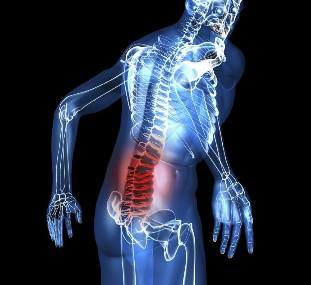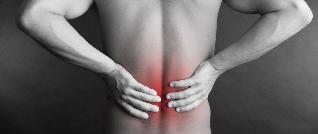
Signs of lumbar osteochondrosis are difficult to spot immediately.Symptoms appear slowly, the diagnosis is already made at the stage of the disease getting worse.It is important to differentiate between spinal collapse and other diseases so that we can see a doctor immediately. Main signs of osteochondrosis of the spine in the lumbar spine:
- My back hurts. At first, it only manifests itself when lifting weights, but then it becomes permanent. This can no longer be associated with any action. At the moment of exacerbation, the pain is unbearable and needs to be stopped immediately.
- Impaired foot sensitivity. This is due to damage to the nerve endings. At the very beginning there is a characteristic tingling, burning sensation, "goose hills" appearing under the sacrum. As the disease progresses, extinction of tendon reflexes and muscle weakness are observed in the lower extremities.
- Excessive sweating.
- Restriction of movement due to constricted nerves. When turning, bending, changing posture, there are pain attacks, similar to an electric shock.
- Limbs, cold skin, blanching.
- In severe cases, sexual dysfunction occurs, urination problems.
Without timely treatment, lumbar osteochondrosis can lead to paralysis and disability.
Exacerbation of the disease
Exacerbations occur during periods of relative remission. They are characterized by a shot, a sharp pain that surrounds and passes through the sciatic nerve. As a result of the development of the disease, numbness reaches the toes. Such attacks disrupt the functioning of the organs and systems of the pelvis. This results in erectile dysfunction, constipation and urinary incontinence.
Characteristics of lumbar osteochondrosis in women
Pelvic pain due to lumbar osteochondrosis adversely affects the reproductive system of the female body.As the disease progresses, the menstrual cycle is interrupted and its dependence on seizures of osteochondrosis can be observed.Osteochondrosis can cause preterm birth or miscarriage during pregnancy.
Treating osteochondrosis: main directions
Osteochondrosis of the lumbar spine requires various therapies. Only an integrated approach can achieve a positive result. The use of medications only alleviates the pain syndrome, does not affect the cause of the disease. To get rid of the disease, you need to use acupuncture, hirudotherapy, therapeutic massage, vacuum, and change your normal lifestyle. The treatment plan should be prescribed by professionals, taking into account the stage of osteochondrosis, individual drug tolerance, and the presence of chronic pathologies.

In the acute phase and in remission, the treatment regimen differs significantly. In case of aggravation, you must first relieve the stress on the spine. To do this, the patient must lie down. It is better to use an orthopedic mattress with pillows for the neck and lower back. There is a need to take muscle relaxants to help relax and relieve cramps. Injections of lidocaine and novocaine are used to reduce the consequences of tightening nerve endings.
The remission period assumes the following treatment regimen:
- Taking vitamin B complexes to normalize the conduction of nerve impulses;
- restoration of blood circulation in tissues due to vasodilators;
- is undergoing physiotherapy to reduce the number of exacerbations. They prescribe special baths, various massages, magnetic therapy, acupuncture;
- Physiotherapy exercises that allow you to build muscle corsets, restore lumbar region mobility, and reduce vertebral load. The exercises are selected individually by the trainer, taking into account the characteristics of the body.
Medications for lumbar osteochondrosis
Medicines are divided according to the forms and methods of exposure:
- anesthetic creams, gels for external use;
- antispasmodics (affect nerves leading to muscle fibers, have a relaxing effect, help reduce seizures, improve blood flow);
- Hormonal anti-inflammatory drugs. They are used for severe, exhausting pain. Hormones suppress inflammation, relieve pain but suppress immunity, flush calcium from bones, and reduce the synthesis of their hormones.
- Chondroprotectors for cartilage repair. They slow down the destruction of cartilage, activate the synthesis of intraarticular fluid, relieve inflammation, stimulate the formation of new cartilage cells;
- Non-steroidal anti-inflammatory drugs. Medications reduce pain, relieve inflammation. You have to take them for a long time. They only eliminate the symptoms, do not affect the cause of the pathology. It negatively affects the mucous membranes of the digestive system, causing gastritis and ulcers.
- Group B vitamins
In addition, sedatives are prescribed to repair the nervous system in osteochondrosis.
Exercise for Lumbar Osteochondrosis

Physiotherapy should be performed regularly, only in this state the effect of the exercises can be achieved.Physical activity should become the norm in people with osteochondrosis of the spine. Not only a special series of exercises, but also walking has a positive effect on the spine.
Certain restrictions must be followed during exercise to reduce the risk of lumbar injury. For example, weight tolerance exercises cannot be performed. This leads to additional stress on the destroyed vertebrae. It is not recommended to twist in the lumbar region either. This is especially true for patients with bumps and hernias.
Physiotherapy should not be performed if the patient has injuries, tumors and hematomas of various origins in addition to lumbar osteochondrosis. Active sports are not recommended for spinal diseases.
Dietary food as a treatment
A well-designed menu helps maintain health and strengthen body strength. The diet should include:
- all kinds of
- cabbage;
- beef liver;
- green peas;
- sea fish;
- berries;
- eggs;
- carrots;
- dried fruits.
Limit salt, pickles, pickles, condiments, alcoholic beverages, strong coffee and tea.
Possibility of surgery
Lumbar osteochondrosis surgery is prescribed only if serious complications develop, such as an intervertebral hernia.The most common way to erase a damaged disk.Surgery is a radical measure, it is used if other methods have not yielded a positive result within six months. Modern medicine has microsurgical and endoscopic treatment methods that are less traumatic.



































